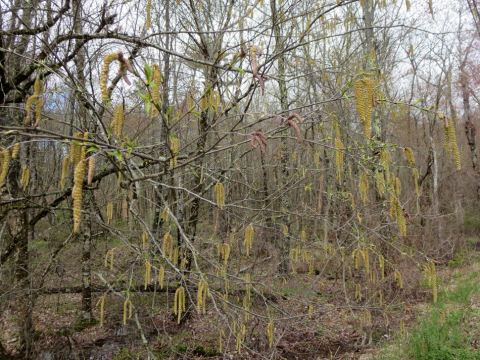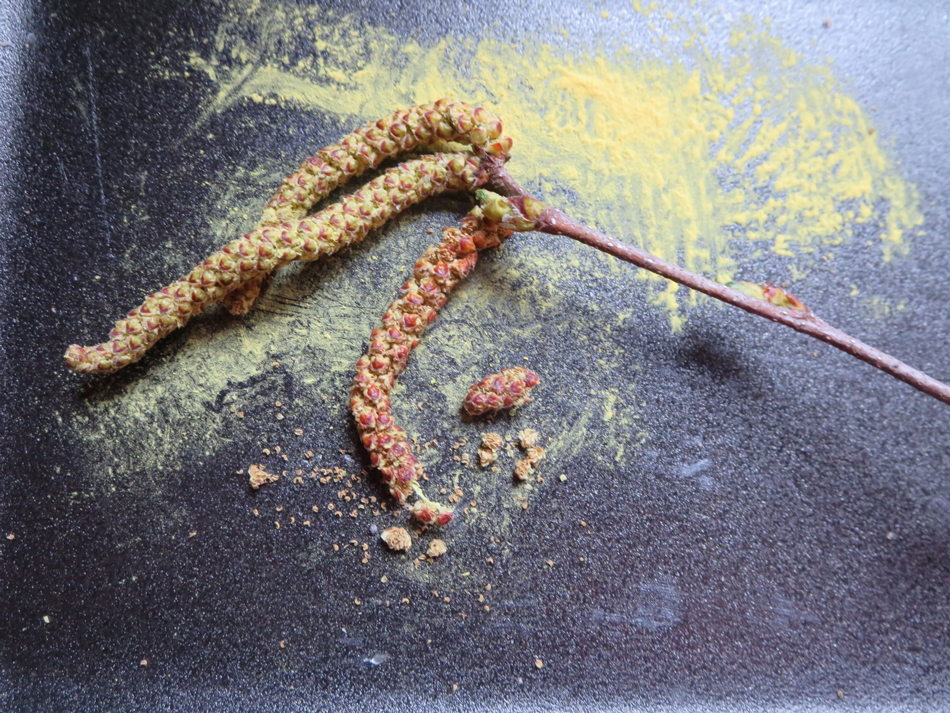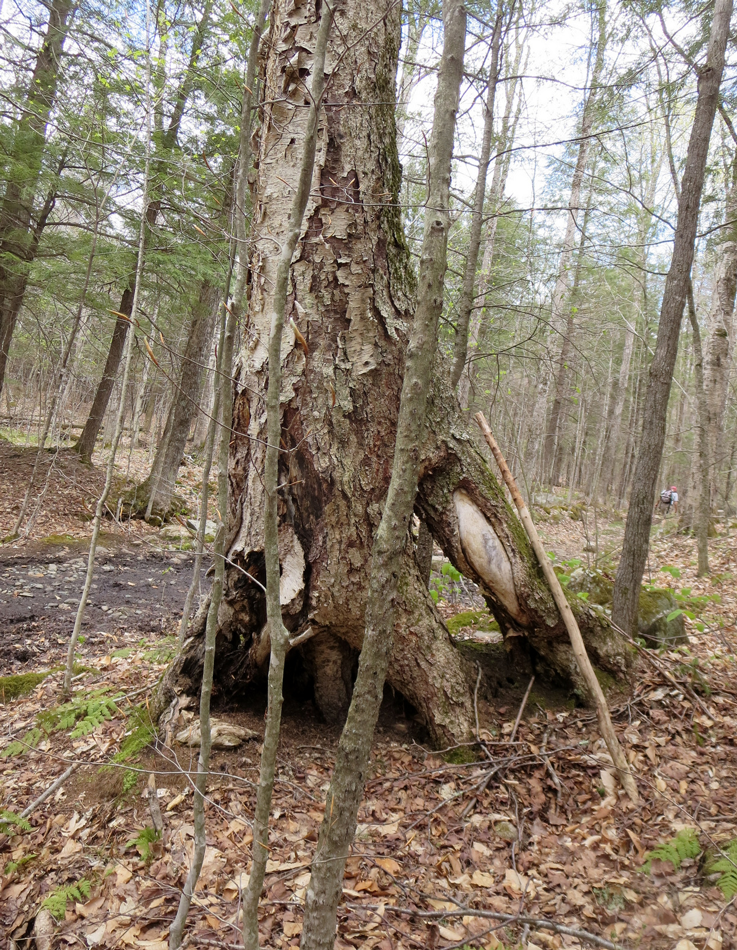
My first discovery of a really big tree was in northern Vermont while walking along a mountain lane. I was astonished to see a huge tree trunk toppled over alongside the path; the thickest trunk I had ever seen in the northeast. I did not recognize its gnarly bark, but after researching huge trees of New England, I determined that it was yellow birch. This is the US Forest Service’s description: Of the birches in the Northeast, the yellow birch is the elite species, by far the most valuable as a timber tree. More than that, it is one of the largest deciduous trees of northeastern America. It may reach 100 feet in height and more than 3 feet in diameter, and may live to 300 years of age. Pioneers told tales of the gigantic yellow birches they saw.”
A mid-succession forest tree, the yellow birch (Betula alleghaniensis) grows after the "pioneer" tree species like gray and paper birch, aspen and pin cherry - species that germinate and grow in full sun in clearings and disturbed land. As these short-lived trees are shaded out, a second wave of semi-shade tolerant, longer-lived trees take over including: yellow and black birch, white pine, red and white oaks, hickories and red maple.
YELLOW BIRCH CHARACTERISTICS
Yellow birch has lustrous, yellowish bark that peels in horizontal shreds, forming curly fringe along the trunk. This is more obvious on younger trees. Michael Wojtech, in his helpful book Bark, has photos of its three distinctive growth and bark stages: young - yellowish gray, mature - bronze to silver, and old - brownish gray to blackish with thick outer bark that breaks into irregular shaped plates. Crushing the leaves and twigs releases a faint wintergreen fragrance, but not as strong as black birch. Its oval, pointed, double-toothed leaves are similar to paper and black birch. They turn bright yellow in fall.

Yellow birch grows throughout New Hampshire but is more common in the White Mountains and north, as it prefers cool summers. In the southern edge of its range, it grows in cool locations like north-facing slopes.
Those of us who ski in New Hampshire and Vermont can easily spot yellow birch trees when we ride chair lifts and look down on the forests below. Yellow birch is the deciduous tree with cones or nutlets at the tops of mature trees, attached to their bare winter twigs. These cones are actually the remains of the upright female seed catkins that were pollinated by windblown pollen from the long drooping male catkins during the previous spring.
Strangely, a lone young yellow birch tree is growing near my mailbox that probably sprouted after the road was installed in the 1970s. It is now about 35 feet tall, and in viewing it with binoculars in early May I could see catkins dangling at the very top. Even more unusual is a little roadside yellow birch in my neighborhood that was loaded with catkins in the early spring, hanging from low branches right at eye-level like a curtain. (See main photo at the top.)
I watched day-by-day as these male catkins that formed on the branch tips last fall began to elongate in late April, before the leaf buds started to open. Birch trees are monoecious, with both male and female flowers growing on the same tree and on the same branch, but not at exactly at the same time.

I discovered last year when I left a few of the long catkins on a black tray that they produce an enormous amount of pollen that is blown by the wind and breezes to fertilize the flowers in the female catkins. They are a major spring allergen as well as the source of the first layer of pollen on porches. However they are not seeds; the female cones that I saw from the ski lift are the nutlets that contain the seeds.

The smaller upright female catkins emerge a few weeks later as the leaf buds are opening. This sequential timing means that the pollen is available for weeks to better survive April showers and storms, and perhaps to enable cross pollination among the trees.
Yellow birches produce prodigious quantities of seed in the cones on a three-year cycle, about 2.5 million seeds per 2 ½ acres, the size of our house lot. Seeds begin to mature in August, but heavy seedfall is not until October. They need this survival technique because germination is low, averaging 20%. The windblown seeds must find perfect soil and climate conditions to germinate and grow.
For example, seeds that germinate in leaf litter die when the litter dries out in summer. Young sprouts may freeze if there is an early frost. Seeds that sprout on long-lasting, moss-covered conifer logs and stumps find optimum growing conditions. Even moss-covered rocks will do, or better yet, disturbed areas in the forest where the soil is exposed offers seedlings a better chance of surviving. Look for weird root structures of mature yellow birch trees. They may grow on and around rocks with a network of roots clinging to the rock until finally finding some soil beneath. A yellow birch that sprouts on a stump may end up growing on a scaffold of roots when the stump eventually rots away. Rich, well-drained soil is needed for survival.

Yet even if the seedlings make it through these early survival tests, they are vulnerable to browsing deer who favor the tasty sprouts. According to the USDA: "Deer consume large numbers of yellow birch seedlings in summer and prefer green leaves and woody stems in fall. Moose, white-tailed deer, and snowshoe hare also browse yellow birch. The seeds are eaten by various songbird species, and ruffed grouse feed on seeds, catkins, and buds. Red squirrel cut and store mature catkins and eat the seeds. Beaver and porcupine chew the bark."
Now that I appreciate how difficult it is for yellow birch trees make it to maturity, I will be monitoring the yellow birch cones growing on my little neighborhood tree. They are down low where I can see them develop. Normally, they form in the tree tops far, from view. Also, I will be looking for huge yellow birch trees while hiking in the White Mountains this summer.
References:
https://www.fs.usda.gov/treesearch/pubs/13723
https://www.srs.fs.usda.gov/pubs/misc/ag_654/volume_2/betula/alleghaniensis%20.htm
New Hampshire's champion Yellow Birch measures at a circumference of 152 inches and a height of 87 feet. It is located in Clarksville, NH, Coos County. These types of Yellow Birches are an integral part of NH's successional forests, creating a unique canopy while providing shade, food, timber, habitat and oxygen.

